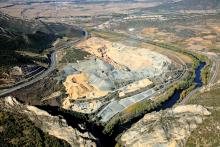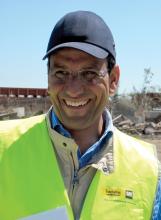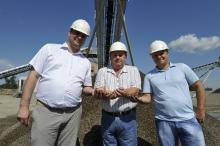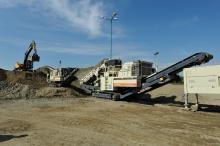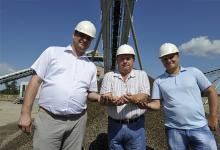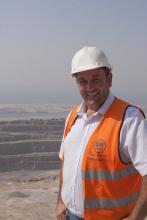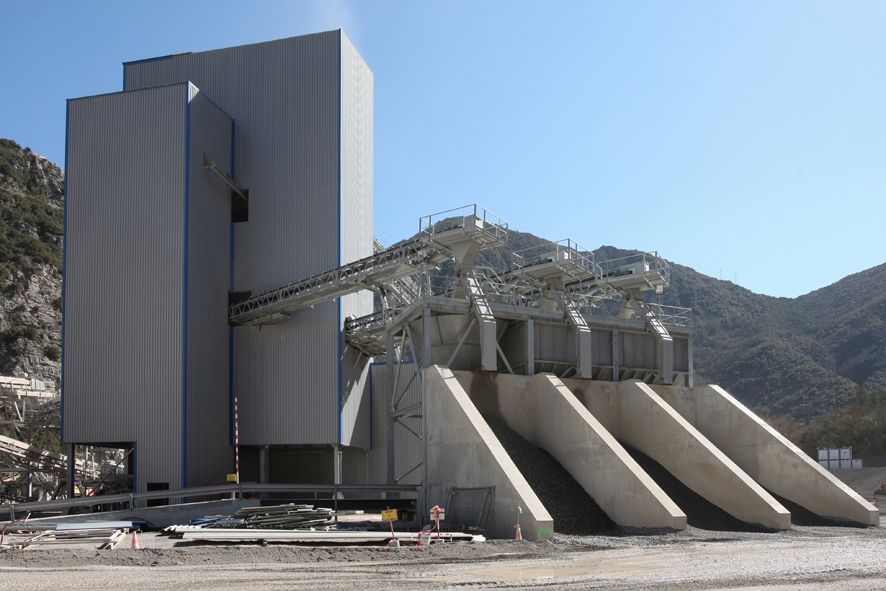
Nice, overlooking the Mediterranean Sea on the French Riviera, has for decades been a tourist hot spot.
The city, France’s fifth most populous after Paris, Marseille, Lyon and Toulouse, is nicknamed Nice la Belle (Nice the Beautiful).
Founded some 2,300 years ago by the Greeks who called it Nikaia after Nike, the goddess of victory, it attracts over four million visitors each year and has France’s third busiest airport.
On my visit the UK’s world-famous Red Arrows Royal Air Force (RAF) aerobatic team was in residence at the airport, and thrilled holiday-makers as nine planes took off three at a time, side by side.
The charm of Nice continues heading north out of the city as villages appear to sit precariously atop steep-sided mountains, topography that continues for some distance.
The route leads past the The Allianz Riviera, the new recently opened stadium of OGC Nice football club, which was built at an estimated cost of €245 million to replace the old stadium.
“We produced a lot of the concrete for this stadium, and we had to make sure it was of very high quality,” says Jean-Raymond Vernet, sud-est directeur régional béton and granulats for
The regional director for concrete and aggregates is accompanied by Hervé Guillemin, technical manager at
The quarry has undergone a €10 million investment programme, replacing much of its older plant with state-of-the-art crushing and screening facilities; conveying equipment and a new water recycling process, all while continuing to produce aggregates and sand.
In February 2012, as part of the plan to optimise production, the new plant at La Courbaisse in the hills above Nice, produced its first tonnes of sand, offering high quality finished products to meet customer demand.
The investment at La Courbaisse is a major one for family-owned Vicat Group, which in 2012 had annual sales of €2,292 billion and 7,700 employees, of which 5,000 are outside France.
Its three business segments cover cement, concrete and aggregate, and it operates in 11 countries (France, Switzerland, the United States, Turkey, Italy, Egypt, Senegal, Mali, Mauritania, Kazakhstan and India) where it has 16 cement manufacturing plants; five grinding centres; 250 concrete batch plants and 70 aggregate quarries.
In 2012 it sold 20 million tonnes of cement; eight million m³ of concrete and 22 million tonnes of aggregates. Turnover figures show 50.4% of sales was generated in the cement business; 36% in the concrete and aggregate business and 13.6% of sales was generated in other products and services (transport, building, chemistry, paper production and prefabrication of concrete products).
Vicat says it has been a leader in the cement and concrete industry for over 160 years, and has achieved a status as an international flagship French company. The group’s founder is said to have invented artificial cement in 1871.
“We have one cement unit at La Grave-de-Peille, near Nice and 14 concrete plants and we have just one quarry in the region at La Courbaisse,” says Guillemin.
“It is necessary that the aggregates/sand quarry never stops production because it is the only local point of production for these concrete plants. One of the targets when we changed the installation was that we did not halt production.”
That production at present, from the limestone deposit (Los Angeles index of hardness, LOS from 19-23; abrasiveness is 50g/tonne), is running at about 720,000tonnes/year. However, the quarry has an extraction authorisation until August, 2017 of 1.2 million tonnes (1.5 million tonnes maximum) with an ongoing extension for a 30-year period. Its reserves are estimated at 45 million tonnes.
Indeed, in the site office Guillemin points to a scale model as he removes layers of the mountain to show how it will look when production ceases.
The quarry was opened in 1987 and to reach the primary location, covering 30 hectares, is no mean feat. From the main road running past a small village, some 17km separate the primary and secondary locations (only 250m as the crow flies) with a difference in height of 200m.
Rainfall is 770mm/year and the temperature varies between 35ºC in summer and -15ºC in winter and this can mean problems with access during the colder periods. A tunnel on the narrow road leading to the quarry can also pose transport difficulties.
The four hectare secondary location, in the bottom of a valley bounded by the River Tinée, houses the new plant much of which is encased in two towers, one 32m high.
At the quarry face in the mountains a sub-contractor drills and vertically blasts some 10,000m³ of 0-600mm material each week.
“We check all our blasts by capturing them on video,” says Guillemin.
“After blasting in the quarry we use a Krupp 1416 impact crusher as our primary crusher and this reduces the rock size to its pre-stock size of 0-200mm.”
A
“At the bottom it opens out to 8m wide and 15m high, leading into an underground gallery some 150m long, 4m wide and 2.5m high. Conveyors take material across the river and to a giant stockpile. Underneath is a new concrete tunnel which conveys material for further processing,” says Guillemin.
Hopper reinstatement was implemented in parallel with the pre-stock, and if necessary the hopper is powered by a Caterpillar 730 articulated dump truck. A Caterpillar 972H wheeled loader and a
All the materials from the quarry, including clay and fines, are sent to the bottom. It is subject to water infiltration inside the mountain pipe, and this was seen as a problem.
Indeed, production capacity and productivity of the quarry were the drivers behind the decision to upgrade along with the desire to reduce the amount of waste clay, which is now recycled as part of the sand process and used in cement production.
Work on the first phase of the project, the civil works, started in June 2011, and the quarry had to be kept operating. This entailed workarounds to maintain output while erecting the new plant.
Over a period of weeks the equipment installed was tested at the end of the day when quarrying had finished. In December, 2011, the first on-load trials of the new part of the facility were carried out successfully.
The new plant optimises efficiency, achieving daily output of up to 5,000tonnes in two shifts, practically double the previous output.
To maintain regular feed the quarry is equipped
The quarry also has an automatic loading system for concrete aggregate in order to minimise the use of machines such as diesel-powered loaders.
Preparatory work for the upgrade saw 18 months of studies, which when completed had involved 10,000 hours of studies, including 1,000 hours of calculation. Construction involved more than 1,000tonnes of structure; 18.5km of cables and 40,000 hours of building. The project is part of the installation for CE certification
“The budget of about €10 million was made up of mechanical work (€6 million), civil engineering (€1.4 million), electrical work (€1 million) and sand processing, water and sludge equipment (€1.3 million),” says Guillemin.
An average number of 34 people, with a maximum of 62 people, worked for more than 40 weeks to complete the complex project, which now has a rated capacity of 550tonnes/hour.
At present there is an on-site staff of 13 people (three extraction, four load weighing and six installation and management).
Finished products include road materials (dry goods) sands 0-2mm and 0-4mm; chippings 2-4mm, 2-6mm and 4-6mm; gravel 6-10mm and 10-20mm and pierre 20-40mm along with graves GNT 0-16mm and 0-20m and GNT 0-31.5mm and 0-63mm. Washed products for concrete production are sand (recomposed) 0-4mm; MF 3mm and MF 3.2-3.4mm and MF gravel 6-16mm and 16-22.4mm.DUMP TRUCKS
1 x Caterpillar 730 ADT
1 x Terex TR40 rigid dump truck
2 x Terex TR45 rigid dump truck
EXCAVATORS
1x Caterpillar 345 DLME excavatorWHEELED LOADERS
1 x Caterpillar 980 wheeled loaderCRUSHERS
1 x Krupp 1416 impact crusher
1 x Metso NP1315 impact crusher
2 x Magotteaux 2400 MAG’Impact II crushersSCREENING
2 x Metso CVB2060 three-deck screens
1 x Bivitec screen
2 x Ellivar 20 screens“We want to produce sand like that from the river, and we have three crushing machines after the primary,” says Guillemin.
“After material leaves the pipe we have two Metso CVB2060 three-deck screens and we wash the material using 800m³/hour of water. At this point material from 0-22m goes to bunkers for our concrete production. Above 22mm goes to the crushing machines.
“We have a Metso NP1315 impact crusher and two
“Material between 22-150mm goes to the Metso impact crusher and we reduce it to 0-60mm or maybe less and from here it goes into the Magotteaux crushers to reduce further what is not reduced in the impact crusher. We need 50% sand and 50% gravel. This is done in the Magotteaux machines.”
Further screening is carried out using a Metso TS 4.3 three-deck screen and a Bivitec screen. The building called tertiary has two Ellivar 20 screens.
During the processing of sand, water and sludge, the new plant has the ability to clarify 750m³/hour of pulp after the cyclone overflows.
The equipment was supplied by French company Sotres, a leader in sands processing plants.
Waste water discharged into a collecting pit is conveyed to the settling tank and this is followed by the flocculation process where sludge and water are separated with purified water overflowing from the upper part of the settling tank.
Sludge is discharged from the bottom part on the settling tank and the separation of solid and liquid is carried out using a filter press, which was supplied by Italian company Filmac (part of the Sotres group).
Clear water comes out of the press’s filtering clothes while dehydrated sludge comes out of the filter press in the form of cakes, which are then stockpiled.
“We recycle 97-98% of the water,” says Guillemin
“Now, everything we need is here at La Courbaisse. Sand is an integral part of concrete and now we produce it here as well as the gravel, and we also have plenty of clean water.”

